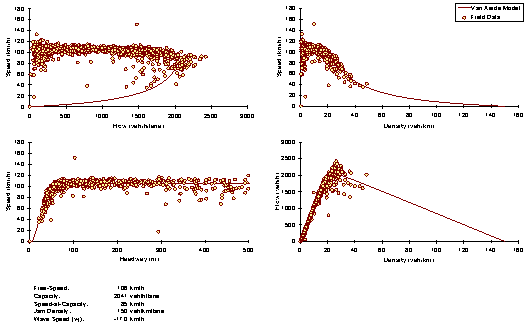Empirical Studies on Traffic Flow in Inclement Weather
Appendix B: Model Formulation
The functional form that is utilized in this study is the Van Aerde nonlinear functional form that was proposed by Van Aerde (Van Aerde 1995) and Van Aerde and Rakha (Van Aerde and Rakha 1995), which is formulated as:
![]() . [7]
. [7]
As was demonstrated by Rakha and Crowther (2002) this functional form amalgamates the Greenshields and Pipes car-following models where hn is the spacing or distance headway (km) between vehicle n and vehicle n-1 in the same lane, un is the speed of vehicle n (km/h), uf is the facility free-flow speed (km/h), c1 is a fixed distance headway constant (km), c2 is a variable headway constant (km2/h), and c3 is a variable distance headway constant (h-1). This combination provides a linear increase in vehicle speed as the distance headway increases with a smooth transition from the congested to the uncongested regime. This combination provides a functional form with four degrees of freedom by allowing the speed-at-capacity (uc) to differ from the free-flow speed (uf), which is a common assumption in a number of models, including the Pipes and Gipps model, or half the free-flow speed, as is the case with Greenshields model. Specifically, the first two parameters of Equation [7] provide the linear increase in the vehicle speed as a function of the distance headway, while the third parameter introduces curvature to the model and imposes a constraint on the vehicle’s speed to ensure that it does not exceed the facility free-flow speed through the use of a continuous function. Demarchi (2002) demonstrates that by considering three boundary conditions the model constants can be computed as:
![]() . [8]
. [8]
Ignoring differences in vehicle speeds and headways within a traffic stream and considering the relationship between traffic stream density and traffic spacing, the speed-density relationship can be derived as:
![]() , [9]
, [9]
where k is the traffic stream density (veh/km) and u is the traffic stream space-mean speed (km/h) assuming that all vehicles are traveling at the same average speed (by definition given that the traffic stream is in steady-state). A more detailed description of the mathematical properties of this functional form can be found in the literature (Rakha and Crowther 2002; Van Aerde and Rakha 1995), as can a discussion of the rationale for its structure.
Of interest is the fact that Equation [9] reverts to Greenshields’ linear model, when the speed-at-capacity and density-at-capacity are both set equal to half the free-speed and jam density, respectively (i.e., uc=uf/2 and kc=kj/2). Alternatively, setting the speed-at-capacity to the free-speed (uc=uf) results in the linear Pipes model given that
![]() .
.
The wave speed at jam density (denoted as wj) can be computed by differentiating the speed-density relationship with respect to density at jam density, to be
![]() .[10]
.[10]
By applying Equation [10] to [9] we derive
 . [11]
. [11]
Considering, a typical lane capacity of 2,400 veh/h, a free-flow speed of 110 km/h (which is typical of U.S. highways), and a jam density of 140 veh/km/lane, the wave velocity at jam density ranges between approximately -11.5 to -20.3 km/h, when the speed-at-capacity is varied from 80 to 100 percent the free-flow speed (which is typical on North American freeways).
As was demonstrated earlier, the Van Aerde model reverts to the Pipes linear model when the speed-at-capacity is set equal to the free-flow speed. Consequently, it can be demonstrated that under this condition the wave speed of reverts to
![]() , [12]
, [12]
which is the speed of the linear model. Furthermore, when uc=uf/2 and kc=kj/2 the wave speed at jam density is consistent with the Greenshields model estimates and is computed as
![]() . [13]
. [13]
If we consider the Van Aerde functional form the optimization model can be formulated as
![]() . [14]
. [14]
 [15]
[15]
Where ui, ki, and qi are the field observed space-mean speed, density, and flow measurements, respectively. The speed, density, and flow variables with hats (^) are estimated speeds, densities, and flows while the tilde variables (~) are the maximum field observed speed, density, and flow measurements. All other variables are defined as was done earlier in describing the Van Aerde functional form.
The objective function ensures that the formulation minimizes the orthogonal error between the field observations and the functional relationship – in this case the Van Aerde functional form. The distances are normalized in order to ensure that the objective function is unitless in order to minimize an objective function over different domains. The initial set of constraints, which is nonlinear, ensures that the Van Aerde functional form is maintained, while the second set of constraints is added to constrain the third dimension, namely the flow rate. The third and forth set of constraints guarantees that the results of the minimization formulation are feasible. The fifth set of constraints, ensures that the four parameters that are selected do not result in any inflection points in the speed-density relationship (i.e., it ensures that the density at any point is less than or equal to the jam density). A detailed derivation of the final constraint is provided elsewhere (Rakha 2006). The sixth set of equations provides estimates for the three model constants based on the roadway’s mean free-flow speed (uf), speed-at-capacity (uc), capacity (qc), and jam density (kj). The final set of constraints provides a valid search range for the four traffic stream parameters that are being optimized (uf, uc, qc, and kj).
A heuristic tool was developed (SPD_CAL) and described elsewhere to calibrate traffic stream models. The procedure can be summarized briefly as follows:
- Aggregate the raw data based on traffic stream density bins in order to reduce the computational space.
- Initialize the four traffic stream parameters uf, uc, qc, and kj, and call them uf0, uc0, qc0, and kj0.
- Construct the model functional form and move along the functional form at increments of Δk to compute the objective function. The accuracy of the objective function computation and the computational speed will depend on the size of the Δk variable.
- Vary the four parameters ufi, uci, qci, and kji at iteration i from ufmin, ucmin, qcmin, and kjmin to ufmax, ucmax, qcmax, and kjmax at increments of ufinc, ucinc, qcinc, and kjinc.
- Construct the model functional form for each parameter combination and move along the function form at increments of Δk/i to compute the objective function. Note that the computational accuracy increases as the iteration number increases.
- Compute the set of parameters ufi, uci, qci, and kji that minimize the objective function.
- Reduce the search window by a factor of 1/i and compute ufmin, ucmin, qcmin, and kjmin to ufmax, ucmax, qcmax, and kjmax at increments of ufinc, ucinc, qcinc, and kjinc.
- Go to step 3 and continue until either the number of iterations is satisfied or the minimum change in objective function is satisfied.
Figure B.1 Van Aerde Model Fit to Freeway Data (Twin Cities, USA)

The fit to five-minute data from the Twin Cities, Minnesota, demonstrates that the calibration tool is able to capture the functional form of the data. The figure clearly demonstrates the effectiveness of the proposed calibration tool together with the Van Aerde functional form to reflect steady-state traffic stream behavior on this facility over multiple regimes.
| Previous Section | Home | Top